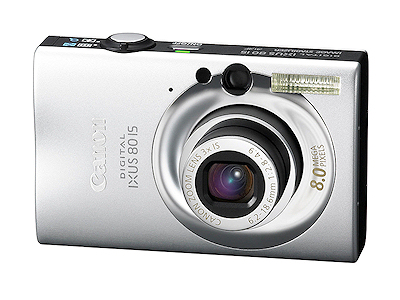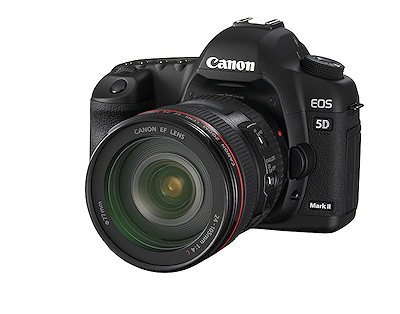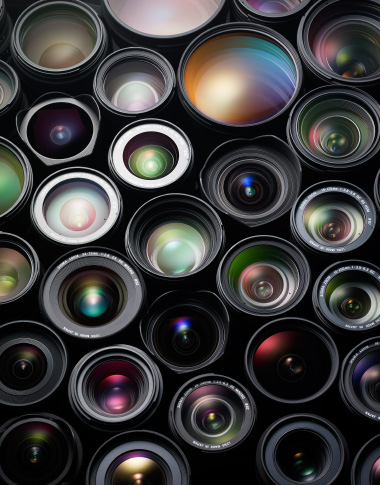



| Feature | Compact | Bridge | Reflex |
|---|---|---|---|
| Dimensions | Low (fits in a shirt pocket) | Middle (the equivalent of two fists) | Large (size varies from 1 / 2 L to the size of a suitcase full (1)) |
| Weight | Very light (less than 200g) | Lightweight (100 to 400g) | Heavy (between 500g and several kilos (1)) |
| Ease of use | Very simple | Very simple to medium, may require to read the manual | Medium to complicated, requires to read the manual |
| size photos (2) | Between 6 and 10 megapixels | Between 8 and 14 megapixels | Between 10 and 22 megapixels |
| Sensor Size | 4.29 x 5.76mm | 5.7 x 7.6mm | 24 x 36mm |
| Optical quality | Low | between low and medium | Depends on the target |
| Shutter Speed | 1 / 1'500th up to 15 seconds | 1 / 4'000th to 15 seconds | 1 / 8'000th to 30 seconds + bulb (bulb or b) |
| aperture | F/2.8 to F/5.9 | F/2.8 to F/4.5 | F/1.2 to F/22(3) |
| Focal Length (4) | 28-112mm | 24-840mm | 8-3'840mm(5)(6) |
| ISO(7) | 80-1'600 (400) | 80-3'200 (800) | 50-25'600 (6'400) |
| type referred | By rear screen | By rear screen or viewfinder offset | By rear screen or pentaprism TTL (through the lens) |
| Built-in flash | Yes, medium range: 4m | Yes, medium range: 7m + flash shoe | Not always, medium range: 12m + flash shoe |
| Video Mode | Yes, on average 640 x 480p, 30 img / s | Yes, on average 1280 x 720p, 24 img / s | Not always, 1920 x 1080p, 30 img / s |
| Types photo files | JPG | JPG + RAW(not always) | JPG + RAW |
| Connections | Mini USB 2.2 | Mini USB 2.2, mini-HDMI, output A/V (PAL/NTSC) | Mini USB 2.2, Mini-HDMI, Video output (PAL / NTSC), external remote jack, mini jack for stereo microphone |
| Types of memory cards(8) | SDHC | SDHC | SDHC, CF |
| Capacity of the batterie(9) | 240 photos | 370 photos | 1'000 photos |
| Prices(10) | 62.00€ to 241.00€ | 163.00€ to 410.00€ | 364.00€ to 5'597.00€(11) |
We start this section by showing three small graphics of three variables in pairs:
- Speed and aperture - aperture and iso - iso and speed
After the material lesson and instead directed adjustment of the camera, we will see
how to compose the photos by three simple rules.
Already, the rule of thirds. As its name suggests, we will compose the picture as four lines and four important points:
To translate this figure into words, let's just say that when taking a photo, if the soil we are interested
we put it on 2 / 3 of the photo and 1 / 3 of heaven, if heaven before us, simply reverse:
2 / 3 of heaven and third floor. Like left and right with their elements, that's for the lines.
Now, for the points, it's just as simple: we simply place the important point of our subject (eye node, center, etc ...)
the crossing of two lines of third parties: we call the''hot spot''. For example, a picture of a bird looking to the right, we'll put the eye
about the top left, to leave space for the eye to that is not found it blocked by the edge of the photo.
Leaving 1 / 3 soil and 2 / 3 of the sky, it increases the ability to fly the bird, the sky is his kingdom. I agree, this may seem little
but this is what gives dynamics to the picture. In general, the size of photos come in 2 / 3, it is no accident.
It is often said that we should not focus (the''full''pellet as the call) but when you make a symmetrical composition, it reinforces the symmetry
sought. They also say that making square format breaks the rule of thirds, but a square format is great for symmetry centered precisely.
Second point of this part of the course: The brightness, again relatively simple.
Just do not have zone''blocked''(black) and no areas ''burned''(white). For example, a sky full
white house well lit and then a bridge where the bottom is completely black but the sky much detail clouds.
For this, a bridge or a reflex, just look at the small scale on which a cursor moves according to where
you point the camera: it is the brightness scale. If the cursor is at the center, the light is balanced, if instead the cursor looks
one side or the other, it must be corrected, at the risk of having a bad light (if the cursor from left, is too dark,
if he goes right, it's too light.).
Last point for this part : the Focus.
Usually, the Focusing have to be on the subject. If the subject have them : on the eyes, beceause it's the most importante part of the animals.
This part was not very long or difficult, but it's the bases of the photographer.
Last section of this lesson : the accessories. And they are a lot. From the wifi memory card to the submarine case.
There is the list of the accessories we'll see during this lesson :
- the lenses
- the memory cards
- the batterie
- the flashs (integrated or not)
- the remote controler (principaly for the DSLRs)
- the filters
- the tripods and monopods
- the transport and the protection of the photo material.
- - -
The lenses. I'll not do a detailled description of all the lenses, only the most used and some specials.
The first lense we have is the 18-55mm F/3.5-4.5., It's the trans-standard basical lense. It's not wonderfull but it can do everything basic. Cheap, small, light,
in a word, it's perfect for beginning.
Juste after, we have the 50mm '' super-bright at F/1.4, the perfect lense for portraits and low luminosity. This lense is interesting because it's the same focale lenght
as the human eye and it's the cheapest focale because very easy to build.
We may have a 55-200mm or 70-300mm F/4-5.6 for long-range focale, small, light and cheap, like the 18-55mm and doing the following range from the basical lense.
This lense is quickly bought from the people that want to see far away. Some, like the 70-300mm form Sigma, have the ''macro''mod for taking some insects's photos.
Now we will see a very better quality than the first ones with the Canon ''L'' series (the red ring), the Sigma ''EX'' series and the Nikon ''VR'' series.
The first one is the Canon 24-105mm F/4L, it stay at the same aperture (same luminosity) for all the ranges. Plus his good optical quality, it has a macro-mod
the allow it to be used from 20cm from the subject.
In the long-range focals it existed a Canon 1'200mm F/5.6, but now it's a Sigma EX 800mm F/2.8. It's a monstruouse lense that can be used only with a tripod.
Sigma again : the Fisheye 8mm F/3.5 EX that can lake half-spherical photos at 180°, if we aren't carefull, we may have our feet on the photo.
Between these two extrem-lenses, there is the Nikon serie ''G'' 17-70mm F/2.8, a important minus-max focal range and heavy too.
In the longe-range, there is the famous ''white body and red head'', the Canon 70-200mm F/2.8L IS USM II. The one that every Canon users are dreaming.
After seeing far away, what about watching close to us : the macrophotos, maybe wih the Canon 100mm macro F/2.8L.
Or, for usinf a more powerfull super-macro-lense, the Canon MPE-65mm F/2.8. When the other lenses have a magnificient of 1:1 max, this one is going to 5:1
and if we have a teleconvertissor 2x, it's going to be a 10:1 ! Like a microscope.
In the particular lenses, there is the Canon 24mm Tilt-Shift, with this lense, we can do some interessting things like correcting a building because of the
lense deformation or doing a ''maquette'' effect.
There were some basicals and specificals lenses.
- - -
Let's talk about the cards mémoire.Pour Compact and bridges, are generally used in SD cards, SDHC, MMC, Memory Stick and Memory Stick PRO Duo.
The Memory Stick and Memory Stick PRO Duo is specifically designed and used only by Sony. SDHC cards are high-capacity version of SD cards,
these do not exceed 4GB.
For the SLR, there are the same size card, but are added CF cards (Compact Flash).
In 2011, the capacity of cards ranging from 2GB to 64GB and transfer rates of up 60Mo/seconde.
Some cards also have an integrated wireless module to unload the card as and when a computer nearby.
The card brands are generally Sandisk, Lexar and Sony.
Where a 2 or 4GB card base (6Mo/seconde) is more than enough for a compact, it is better to take a card of
4 or 8GB Ultra II (15Mo/seconde) for bridges and entry-level SLR . Reflex for the greedy, if it is small enough,
it is mieus take CF cards in 16GB Extreme III and Extreme IV 60Mo/seconde.
- - -
A quick about batteries. The compact has a low capacity, a bridges medium-size and a reflex has high capacity and the ability
to have multiple batteries with a''grip''(something that is screwed in the housing and in which was a''rack''may contain
two batteries or 6 batteries). It takes between 1 and 5 per mAh picture taken, what makes a full battery of 2'000mAh can make
between 400 and 2,000 photos, depending on the use of flash, autofocus, zoom, the use of the rear screen etc ...
- - -
The flashes, they are integrated or external are chasms to electricity, so it is better to cells or batteries.
The flashes are the most integrated 5x less powerful than the external flashes and less powerful 25x worse. Another difference
is that we can not direct the flash, but they are much less great. A good external flash can be up to 50m and automatically
adjust the power he must give the lightning flash.
The flash is very useful in low light conditions but also in direct sunlight, such as backlighting that can lead to''shadow''
: Do not have a silouette all black and a blue sky, but to have color and texture in place of the black silouette. It also,
if it is used to highlight the texture of such a wall plastered by positioning it in oblique light.
- - -
The remote controls are extremely useful in cases of long exposure: not to shake the camera when the trigger (but you can always use the
timer to the case of long exposures without having to trigger instant). You can also use the remote when using long lenses and that
it is slow compared to the focal length. You can also find automated triggers, that take a photo every X seconds, it is a very useful
little box to make timelapse videos (they are videos whose images are taken more slowly than its rendering speed (by example,
one photo per second, and then put 24 pictures per second for the video)).
- - -